Boeing 737-236

British Airtours Flight KT28M, G-BGJL
Manchester, UK
August 22, 1985
British Airtours Flight KT28M, a Boeing Model 737-200 series airplane, was taking off from Runway 24 at Manchester International Airport, Manchester, UK, when the left engine experienced an engine failure. The flight crew aborted the takeoff and thinking the airplane had suffered from a tire burst, taxied the airplane clear of runway 24. In fact, a piece of the left engine combustor had penetrated a fuel-tank access panel, causing an uncontrollable fuel spill. The captain called for an evacuation; however, the fuel ignited and, accelerated by the adverse positioning of the airplane relative to the wind, the airplane was burned severely. Fifty-five passengers perished as a result. The British Civil Aviation Authority (CAA) determined the cause of the accident (fuel spill/ensuing fire) was an engine failure caused by faulty repairs; fragments from that engine failure penetrating a fuel-tank access door insufficiently constructed to withstand the impact from the failed engine pieces.
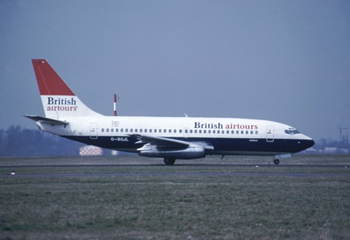
British Airtours Flight KT28M, a Boeing Model 737-200 series airplane, was a charter flight from Manchester, UK to Corfu (a Greek Island).
There were 131 passengers and six crewmembers on board. At 0608, the flight crew was cleared to taxi to Runway 24 for departure. At 0612, the airplane had lined up on the runway and was cleared for takeoff.
The takeoff was to be performed by the first officer. During the takeoff run, the captain made the routine "eighty knots" call and twelve seconds later a "thump" or "thud" was heard. The captain immediately ordered "stop," closed the throttles, and selected reverse thrust. The maximum speed achieved was 126 knots indicated airspeed (IAS). The “thump” heard by the pilots was the sound of an uncontained failure of the left engine. Debris from the failure punctured a wing tank access panel. Fuel leaking form the wing ignited and burned as a large plume of fire trailing directly behind the engine.
The captain initially believed they had suffered a tire burst or a bird strike. The first officer had applied maximum wheel braking, however, because of the possible tire burst, the captain said, "Don't hammer the brakes; don't hammer the brakes." At 45 seconds after the start of the takeoff run, nine seconds after the thud, as the airplane decelerated through 85 knots, the captain radioed Air Traffic Control (ATC) that they were aborting takeoff. The fire bell rang simultaneously, and the captain added, as he cancelled reverse thrust, "It looks as though we've got a fire on No. 1." ATC confirmed this, stating, "Right, there's a lot of fire; they're on their way now." At 25 seconds past the thud, and 20 seconds before the airplane stopped, the crew decided to evacuate via the right-hand side of the airplane. The Model 737 was decelerating through 36 knots then and the captain warned the cabin crew about the evacuation six seconds later.
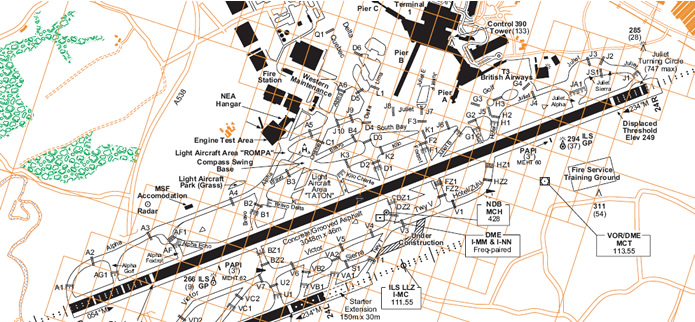
After the airplane stopped, a No. 1 engine fire drill was carried out. The No. 2 engine was shut down and the passenger evacuation drill was carried out. Before completion of this drill, the captain saw fuel and fire spreading forward on the left-hand side of the airplane. Both the captain and first officer escaped through the sliding window in the right-hand side.
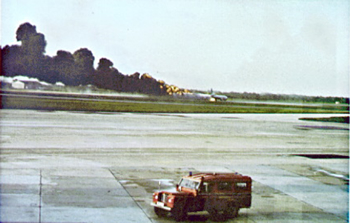
Immediately after the thud, an intense fire developed on the left-hand side of the airplane, causing some cracking and melting of windows with some associated smoke in the aft cabin. This caused some passengers to stand up in alarm and move into the aisle. Immediately after coming to a halt, the purser tried to open the right forward door (R1) but the escape slide container jammed on the doorframe, preventing further movement of the door. He then crossed to the left forward (L1) door and opened it (25 seconds had passed since the airplane had stopped). The purser then returned to the R1 door and managed to clear the obstruction and was able to open the door 85 seconds after the airplane had stopped. Meanwhile, passengers had managed to open the right-over-wing exit. The right rear (R2) door had also been opened, but no one escaped through this exit. In total 17 surviving passengers escaped through the L1 door, 34 through R1, and 27 through the right-over-wing exit.
As the airplane turned off the runway, a wind of seven knots from 250° carried the fire onto and around the rear fuselage. After the airplane stopped, the hull was penetrated rapidly and smoke, possibly with some flame transients, entered the cabin through the right rear door which was opened shortly before the airplane came to a halt. Subsequently, fire developed within the cabin. Despite the prompt attendance of the airport fire service, the airplane was destroyed and 55 persons on board lost their lives.
See Manchester Fire Animation below:
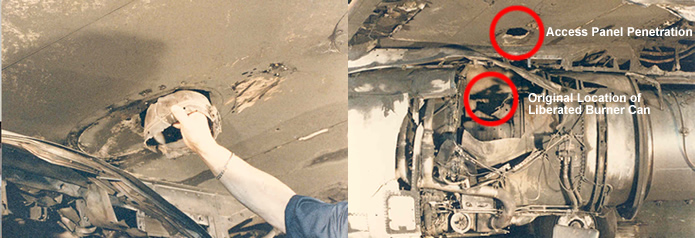
The resulting fire developed catastrophically, primarily because of adverse orientation of the parked airplane relative to the wind, even though the wind was light. Major contributory factors were the vulnerability of the wing-tank access panels to impact, a lack of any effective provision for fighting major fires inside the airplane cabin, the vulnerability of the airplane hull to external fire, and the extremely toxic nature of the emissions from the burning interior materials.
See Manchester Combustion Cans Animation below:
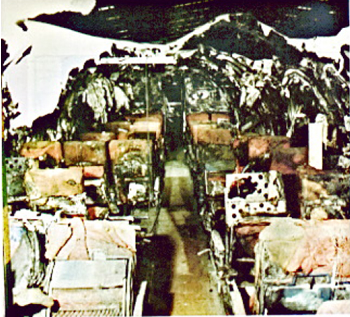
PROBABLE CAUSE: The cause of the accident was an uncontained failure of the left engine, initiated by a failure of the No. 9 combustor can which had been the subject of a repair. A section of the combustor can, which was ejected forcibly from the engine, struck and fractured an under-wing fuel-tank access panel. The fire which resulted developed catastrophically, primarily because of adverse orientation of the parked airplane relative to the wind, even though the wind was light. Major contributory factors were the vulnerability of the wing-tank access panels to impact, a lack of any effective provision for fighting major fires inside the airplane cabin, the vulnerability of the airplane hull to external fire, and the extremely toxic nature of the emissions from the burning interior materials. The major cause of the fatalities was rapid incapacitation due to the inhalation of the dense toxic/irritant smoke atmosphere within the cabin, aggravated by evacuation delays caused by a right forward door malfunction and restricted access to the exits.
(See Sequence of images on the British Air Tours Runway Fire)
(See Sequence of images on the British Air Tours Fuselage)
From the AAIB Accident Report No: 8/88:
The British Aircraft Accident Investigations Branch (AAIB) concluded that the cause of the accident was an uncontained failure of the left engine, initiated by a failure of the No. 9 combustor can which had been the subject of a repair. A section of the combustor can, which was ejected forcibly from the engine, struck and fractured an under-wing fuel tank access panel. The fire which resulted developed catastrophically, primarily because of adverse orientation of the parked airplane relative to the wind, even though the wind was light. Major contributory factors were the vulnerability of the wing-tank access panels to impact, a lack of any effective provision for fighting major fires inside the airplane cabin, the vulnerability of the airplane hull to external fire, and the extremely toxic nature of the emissions from the burning interior materials. The major cause of the fatalities was rapid incapacitation due to the inhalation of the dense
toxic/irritant smoke atmosphere within the cabin, aggravated by evacuation delays caused by a forward right door malfunction and restricted access to the exits.
The AAIB developed 106 findings from this accident. The complete accident report, including these findings, can be found at the following link (AAIB Accident Report No: 8/88).
The AAIB developed 31 safety recommendations from this accident. Ranging in topic from the flight crew's view of the cabin and outside of the airplane, to engine repair guidelines, to various cabin safety requirements and fuel tank access panel construction. Those recommendations can be found in the accident report, found at the following link (Air Accidents Investigation Branch (AAIB) Accident Report No: 8/88).
Fuel Tank Access Panels
Paragraph (e) of section 25.963, "Fuel tanks: general," (14 CFR 25.963(e))
Section 121.316, "Fuel tanks," (14 CFR 121.316)
Cabin Safety
Section 25.813, "Emergency exit access," (14 CFR 25.813)
Section 121.310, "Additional emergency equipment," (14 CFR 121.310)
Fire Fighting
Section 135.177, "Emergency equipment requirements for aircraft having a passenger seating configuration of more than 19 passengers," (14 CFR 135.177)
Section 135.178, "Additional emergency equipment," (14 CFR 135.178)
Miscommunication between Pratt & Whitney and British Airtours about the acceptability of repair types for combustor cans.
The repair carried out in 1983 used the direct-fusion weld method described in the British Airways engine overhaul manual. Solution heat treatment and optional post-weld stress relief, which formed part of the repair procedure in the Pratt & Whitney engine manual at that time, were not carried out. Omission of the above two heat treatments and a further process known as braze/reinforcement was permissible in accordance with the approval granted to British Airways/British Airways Engine Overhaul Ltd by the Civil Aviation Authority. Conflicting evidence was presented on the effectiveness of solution heat treatment; however, it is believed that it would not have had a significant effect on the fatigue life of the can. It was accepted, however, that its inclusion would have facilitated weld repair of the can. The Pratt & Whitney engine overhaul manual did not preclude direct-fusion weld repair of a circumferential crack of any length. Local areas of severe distortion and oxidation were not permitted to be weld repaired. A three-inch circumferential crack length limit had existed in the engine overhaul manual prior to 1977 at which time it was removed by Pratt & Whitney. British Airways was unaware of this preexisting limit, having started operation of the Model JT8D series engine in 1980. A small area of parallel cracking, possibly associated with thermally distressed material, was present on liner 3 of can No. 9 prior to repair and was addressed by fusion weld repair. The manufacturer had advised operators that direct-fusion weld-repaired cans have lower fatigue lives than ones repaired using material replacement techniques but had not quantified this reduction. British Airways interpreted this as applicable to cans with a much greater time in service than any they operated at the time.
Evolution of fuel tank access panel fabrication
Some fuel tank access panels, on some airplane models, were initially constructed from a type of nylon material. This type of construction offered a significant weight savings, using a non-metallic, non-electrically conductive material. However, in some post-crash fire events it was noted that these non-metallic panels to weren’t heat resistant and could melt at temperatures significantly less than adjacent aluminum structure.
In order to address the concern relative to lack of heat resistance of non-aluminum panels, cast-aluminum panels were introduced into some airplane designs. This resulted in a panel manufactured that had stiffening webs integrally formed on the upper (internal) surface but were later shown to be brittle. The panels were nominally non-stressed components so far as flight loads on the wing were concerned, and impact strength did not form a part of the design requirements for the access panel, nor were there any requirements for this capability. The cast aluminum material had an impact strength approximately one-quarter that of the lower wing for airplanes such as the 737.
Improper combustor can repair/weld:
Also, see The Left Engine in the Accident Board Findings Section - Items 23-52
See prevailing cultural/organizational factors for a description of the confusion surrounding the type of repairs appropriate for combustor can cracks.
Because of this confusion, British Airtours performed an improper weld on combustor can No. 9, leading to the engine failure which ultimately caused the fuel leak and fatal fire.
Fuel Tank Access Panel design:
The wing-tank access panel had an impact strength approximately one quarter that of the lower wing skin. As a result, when the ejected dome of the No. 9 combustor can and a small section of the fan case struck an under wing fuel tank access panel, a hole was made in this panel which had an area of 42 square inches. Had the dome struck the adjacent skin, penetration of the tank probably would not have occurred. Neither the access panel nor the lower wing skin were designed to any impact resistance criteria, nor were they required to be.
Also, following this accident, the impact resistant panels were originally placed in locations within one-nacelle diameter of the engines, a design criterion typically associated with fire protection, but not generally associated with protection strategies related to tire and rotor burst zones. Subsequently, upon a reevaluation of the protection criteria, the requirement for impact/fire resistance was extended to all locations that fall within the rotor and tire burst zones.
Escape Slide Malfunction:
A design fault existed with the slidebox lid-release lanyard. This fault caused the door to jam during rapid door opening; the door unlocked normally, but as it was moving out through the aperture, the slide container lid jammed on the doorframe, preventing further movement of the door. As a result, the flight attendant was not initially able to open the door, preventing passengers from evacuating through that door. After opening the door on the opposite side of the cabin, the flight attendant returned to the door and was eventually able to open the door and the slide deployed, as designed.
Combustor Can Weld Repair
It was assumed that the weld repair of the Number 9 combustor can was appropriate. British Airtours had performed a fusion weld on the combustor can. Pratt & Whitney knew that this type of weld was not appropriate for the type of crack that had been repaired. A critical miscommunication by the engine manufacturer and a faulty assumption by the airline led to British Airtours believing that the repair made was in fact appropriate, stating "The manufacturer had advised operators that direct fusion weld repaired cans have lower fatigue lives than ones repaired using material replacement techniques but had not quantified this reduction. British Airtours interpreted this as applicable to cans with a much greater time-in-service than any they operated at the time."
Fuel Tank Access Panel Design
There were no design provisions for impact resistance of the tank access covers, nor was there a regulatory requirement for such.
Escape Slide Jam
It was assumed by manufacturers that the escape slide would deploy when the doors were opened, regardless of the time taken to open the door. However, a design fault with the slidebox lid-release lanyard caused the door to jam during rapid door opening; the door unlocked normally, but as it was moving out through the aperture, the slide container lid jammed on the doorframe, preventing further movement of the door.
Cabin Address System Volume
It was assumed that cabin address system volume would be adequate in all emergency situations. The cabin address system volume was linked to the left engine operation during normal revenue service. The volume needed to be reduced when engines weren't operating. However, during the accident when the left engine failed, the decibel level of the cabin address system automatically dropped to a lower level. As a result, the captain's call for evacuation was initially not heard.
American Airlines, Boeing Model 747-100 series airplane, N743PA, San Francisco, CA - September 18, 1970.
Shortly after takeoff (at approximately 500 feet), the No. 1 engine sustained an uncontained failure of the second-stage turbine disk rim. The turbine blades and rim fragments penetrated the high-pressure turbine (HPT) case, engine cowling, and adjacent airplane structure. All fluid lines, electrical cables, and pneumatic ducts in the pylon area were severed, causing an intense fire which extended over the top of the left wing and lasted approximately three minutes. Two fuel tank access plates on the bottom of the wing inboard of No. 1 pylon were also penetrated by turbine fragments. Although there was no ignition of the fuel which was leaking from these two access plates, the flames propagating over both the top and bottom of the wing posed a definite danger of ignition. No fatalities resulted from this incident.
United Airlines, Boeing Model 747-100 series airplane, N4714U, Honolulu, HI - November 16, 1984.
During takeoff roll, the No. 7 tire exploded as the result of a wheel bearing failure. A fragment penetrated a fuel tank access panel on the right wing, and large quantities of fuel were spilled but never ignited. The airplane was evacuated, with some serious injuries, but no fatalities. The ability of a relatively low speed tire failure fragment to penetrate any part of the wing should have been recognized as a potentially hazardous condition.
Section 121.316, "Fuel tanks," (14 CFR 121.316): Each turbine powered transport category airplane operated after October 30, 1991, must meet the requirements of paragraph (e) of section 25.963 (14 CFR 25.963(e)) in effect on October 30, 1989.
Section 25.963(e), states that "Fuel tank access covers must comply with the following criteria in order to avoid loss of hazardous quantities of fuel: (1) All covers located in an area where experience or analysis indicates a strike is likely must be shown by analysis or tests to minimize penetration and deformation by tire fragments, low energy engine debris, or other likely debris.
(2) All covers must be fire resistant as defined in Part 1 of this chapter."
Section 25.813, "Emergency exit access," (14 CFR 25.813): Established design and construction requirements for emergency exists and access to those exits.
Section 121.310, "Additional emergency equipment," (14 CFR 121.310: Established requirements for certain emergency exits, and lighting and interior/exterior marking for all exits.
14 CFR 135.177, "Emergency equipment requirements for airplane having a passenger seating configuration of more than 19 passengers."
FAA Advisory Circular AC 25.785-1A - Flight Attendant Seat and Torso Restraint System Installations.
AC 25.963-1 - Fuel Tank Access Covers.
AD 89-12-10, amendment 39-6230, applicable to Boeing Model 747-100, -200, -300, and 747-SP series airplanes: To minimize the fire hazard as a result of lower wing surface fuel tank access door penetration due to impact from low energy engine and tire debris.
AD 87-02-07, amendment 39-5506, applicable to Boeing 737 100 and 737-200 series airplanes: To minimize the hazard of lower wing surface fuel tank access cover penetration due to impact from low energy engine debris.
AD 85-25-04, amendment 39-5179 (50 FR 49923, December 6, 1985), applicable to Boeing Model 737-100, -200, and -300 series airplanes: To ensure proper door opening and escape slide deployment.
AD 85-19-04, amendment 39-5141 (50 FR 38505; September 23, 1985), applicable to Boeing Model 737-100, -200, and -300 series airplanes: To ensure proper door opening and escape slide deployment.
Airplane Life Cycle:
- Design / Manufacturing
- Operational
Accident Threat Categories:
- Uncontrolled Fire / Smoke
- Uncontained Engine Failure
- Cabin Safety / Hazardous Cargo
Groupings:
- N/A
Accident Common Themes:
- Organizational Lapses
- Flawed Assumptions
- Unintended Effects
Organizational Lapses
Lack of communication between the engine manufacturers and British Airtours related to combustor can repair, and the consequences of performing what was revealed to have been an inappropriate repair - see discussion in organizational/cultural factors and key safety issue(s).
Fire Fighting - see discussion in organizational/cultural factors.
Improper combustion can repair - see discussion in organizational/cultural factors and key safety issue(s).
Flawed Assumptions
British Airtours assumed that the type of weld used for the combustor can repair was appropriate for that application, when in fact the engine manufacturer knew that it was not.
Unintended Effects
The cabin address system volume was linked to left engine operation. During normal revenue service, the volume needed to be reduced when engines weren't operating. However, during the accident when the left engine failed, the decibel level of the cabin address system automatically dropped to a lower level; as a result the captain's call for evacuation was not initially heard.
United Airlines Flight 227, Salt Lake City, Utah, November 11, 1965, Boeing 727
As a result of a high descent rate on final approach, and late pilot action to arrest the descent rate, the airplane landed hard, short of the runway, resulting in the failure of the main landing gear and aft fuselage, and causing a failure of high-pressure fuel lines in the fuselage. The resulting uncontrolled fuel leak ignited due to electrical and/or fuselage sparking. The high-pressure fuel leak continued to feed the fire, and fatalities among passengers and crew resulted, due to the fire, and difficulties during the evacuation.
See accident module
Overseas National Airlines Flight 32, John F. Kennedy International Airport, New York, November 12, 1975, McDonnell-Douglas DC-10-30
During takeoff roll, the right engine suffered an uncontained failure resulting in a fuel-fed fire in the engine. The takeoff was aborted, but the airplane overran the runway and burned, largely due to pooled fuel around the airplane. All passengers and crew successfully evacuated the airplane, and there were no fatalities.
See accident module
China Airlines Flight CI 120, Okinawa, Japan, August 20, 2007, Boeing 737-800
Following landing, while chocking the airplane with the engines still running, the ground crew noted a large fuel leak from around the number 2 engine. The fuel leak ignited and consumed the airplane. The fuel leak was caused by a failure in the leading-edge slat system, that occurred while retracting flaps during taxi. The airplane was destroyed, but no fatalities resulted.
See accident module
(Incident) United Airlines, N4714U, Honolulu, Hawaii, November 16, 1984, Boeing Model 747-100
During takeoff roll, the No. 7 tire exploded due to a wheel bearing failure. A tire fragment penetrated a fuel tank access panel on the right wing. Large quantities of fuel were spilled but never ignited. The airplane was evacuated, with some serious injuries, but no fatalities. The ability of a relatively low speed tire failure fragment to penetrate any part of the wing should have been recognized as a potentially hazardous condition.
Technical Related Lessons:
Unrestricted fuel leaks during ground operation (taxi, takeoff, and landing), particularly those which breach the fuel tank, pose an extreme hazard to the aircraft and occupants. (Threat Category: Uncontrolled Fire)
- As a root cause of this accident, a portion of a failed combustor penetrated a fuel access panel that was not impact resistant, creating a massive fuel leak in the left wing. Ignition sources were readily available from hot brakes and engine components, and the leaking fuel ignited, leading to an uncontrolled fire, which consumed the airplane, and resulted in a large number of fatalities. There was no capability on the airplane to mitigate or eliminate the associated hazards, leaving the airplane completely dependent on airport crash, fire, and rescue responses, a timely evacuation, and design/certification measures intended to limit the flammability of airplane materials and structure. Had impact resistant access panels been installed, it is possible that the fuel leak would not have occurred.
Fuel tank access panels should be designed to a level of impact/fire resistance appropriate to the expected threat. Fire and impact resistance must be considered in the design of components that fall within the tire and rotor burst zones, especially those whose failure could lead to an uncontrollable fuel leak. (Threat Category: Uncontrolled fire)
- In this accident, a portion of the number nine combustor can penetrated a fuel access panel in the proximity of the engine. The ensuing fuel leak ignited, leading to the catastrophic fire. Following the accident, impact resistant panels were required to be installed in tire and rotor burst zones. Non-resistant (original) designs are allowed in non-vulnerable locations. For some design applications, the impact/fire resistant panels are able to be physically interchanged with the non-resistant design and stenciling/placards are used to identify locations where fire/impact resistant panels are to be installed.
Emergency exit door function should be evaluated in the expected usage conditions (rapid door opening, etc.). (Threat Category: Cabin Safety/Hazardous Cargo)
- During the evacuation, a cabin attendant attempted to open one of the cabin doors, only to have it jam as a result of his attempt to open it rapidly. This failure mode was not identified during door or evacuation testing, and only identified itself during an actual evacuation. The failure resulted in that particular door being unavailable, at least for the initial portion of the evacuation, and may have inhibited the evacuation process, possibly contributing to the catastrophic outcome of the accident.
Passenger survivability can be substantially influenced by toxicity of smoke and gases from burning cabin material. (Threat Category: Cabin Safety/Hazardous Cargo)
- A number of the fatalities in the accident resulted from inhalation of toxic vapor or substances that were byproducts of burning cabin material. Flammability standards at the time of certification of the 737 required that cabin materials not be combustible, or that when ignited, were self-extinguishing within a short time period. The intensity of this fire overwhelmed the flammability resistance of the cabin materials. Toxic substances were released that incapacitated passengers and prevented their evacuation from the airplane. Following several fire related accidents, the flammability standards of cabin materials were revised.
Common Theme Related Lessons:
Engine repairs should be accomplished in accordance with clear instructions provided by the original engine manufacturer or approved alternative procedures. If alternate procedures are used, an assessment of the effects on engine ratings, limits, margins, reliability, and subsequent maintenance and overhaul intervals and procedures should be accomplished. (Common Theme: Organizational Lapses)
- The Pratt and Whitney JT8D engine on British Airtours 737-200 was repaired in accordance with procedures approved by the British CAA and were based upon information obtained from the engine manufacturer. Pratt and Whitney repair instructions provided general guidance for repairs which were accomplished, but there appeared to be confusion regarding the ultimate impact of the repaired engine regarding fatigue life. This misunderstanding resulted in the repaired combustor remaining in service beyond its fatigue life, and an uncontained engine failure resulted.
